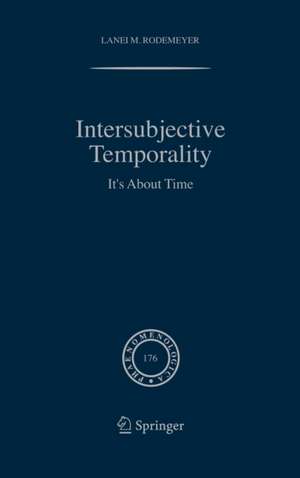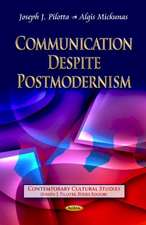Intersubjective Temporality: It's About Time: Phaenomenologica, cartea 176
Autor Lanei M. Rodemeyeren Limba Engleză Hardback – 8 feb 2006
| Toate formatele și edițiile | Preț | Express |
|---|---|---|
| Paperback (1) | 612.05 lei 6-8 săpt. | |
| SPRINGER NETHERLANDS – 18 noi 2010 | 612.05 lei 6-8 săpt. | |
| Hardback (1) | 618.03 lei 6-8 săpt. | |
| SPRINGER NETHERLANDS – 8 feb 2006 | 618.03 lei 6-8 săpt. |
Din seria Phaenomenologica
-
 Preț: 402.36 lei
Preț: 402.36 lei -
 Preț: 402.00 lei
Preț: 402.00 lei -
 Preț: 409.22 lei
Preț: 409.22 lei -
 Preț: 374.71 lei
Preț: 374.71 lei - 15%
 Preț: 608.59 lei
Preț: 608.59 lei -
 Preț: 401.15 lei
Preț: 401.15 lei - 15%
 Preț: 555.48 lei
Preț: 555.48 lei - 15%
 Preț: 507.06 lei
Preț: 507.06 lei - 15%
 Preț: 612.23 lei
Preț: 612.23 lei - 18%
 Preț: 915.89 lei
Preț: 915.89 lei - 18%
 Preț: 912.55 lei
Preț: 912.55 lei - 15%
 Preț: 618.83 lei
Preț: 618.83 lei - 18%
 Preț: 1177.80 lei
Preț: 1177.80 lei -
 Preț: 374.54 lei
Preț: 374.54 lei - 18%
 Preț: 1070.12 lei
Preț: 1070.12 lei - 18%
 Preț: 915.43 lei
Preț: 915.43 lei - 18%
 Preț: 1646.82 lei
Preț: 1646.82 lei - 18%
 Preț: 1491.23 lei
Preț: 1491.23 lei - 18%
 Preț: 1174.75 lei
Preț: 1174.75 lei - 18%
 Preț: 907.54 lei
Preț: 907.54 lei - 15%
 Preț: 617.72 lei
Preț: 617.72 lei - 18%
 Preț: 1069.51 lei
Preț: 1069.51 lei - 18%
 Preț: 857.19 lei
Preț: 857.19 lei - 18%
 Preț: 911.64 lei
Preț: 911.64 lei - 18%
 Preț: 1176.56 lei
Preț: 1176.56 lei - 18%
 Preț: 910.11 lei
Preț: 910.11 lei - 15%
 Preț: 556.57 lei
Preț: 556.57 lei - 15%
 Preț: 446.38 lei
Preț: 446.38 lei - 18%
 Preț: 807.01 lei
Preț: 807.01 lei - 18%
 Preț: 910.71 lei
Preț: 910.71 lei - 18%
 Preț: 914.96 lei
Preț: 914.96 lei - 15%
 Preț: 619.61 lei
Preț: 619.61 lei
Preț: 618.03 lei
Preț vechi: 727.08 lei
-15%
Puncte Express: 927
Preț estimativ în valută:
109.42€ • 127.40$ • 95.05£
109.42€ • 127.40$ • 95.05£
Carte tipărită la comandă
Livrare economică 24 februarie-10 martie
Preluare comenzi: 021 569.72.76
Specificații
ISBN-13: 9781402042133
ISBN-10: 1402042132
Pagini: 200
Ilustrații: XII, 192 p.
Dimensiuni: 155 x 235 x 17 mm
Greutate: 0.49 kg
Ediția:2006
Editura: SPRINGER NETHERLANDS
Colecția Springer
Seria Phaenomenologica
Locul publicării:Dordrecht, Netherlands
ISBN-10: 1402042132
Pagini: 200
Ilustrații: XII, 192 p.
Dimensiuni: 155 x 235 x 17 mm
Greutate: 0.49 kg
Ediția:2006
Editura: SPRINGER NETHERLANDS
Colecția Springer
Seria Phaenomenologica
Locul publicării:Dordrecht, Netherlands
Public țintă
ResearchCuprins
UNDERSTANDING THE PRESENT: URIMPRESSION VS. LIVING PRESENT.- THE APPRESENTATION OF PERCEIVED OBJECTS86.- WORLD-TIME: A NEW TEMPORAL SYNTHESIS.- HUSSERL’S DEVELOPMENT OF RETENTION.- INTERSUBJECTIVE CONSTITUTION IN RETENTION.- HUSSERL’S DEVELOPMENT OF PROTENTION.- PROTENTION AS LINK TO INTERSUBJECTIVE TEMPORALITY.- INTERSUBJECTIVE TEMPORALITY.
Caracteristici
Thorough analysis of Husserl's understanding of inner time-consciousness Examination of Husserl's later Bernau and "C" manuscripts Development of neglected Husserlian concepts, such as "near" and "far" retention, and "world-time" Offers phenomenological grounds for an understanding of intersubjectivity















